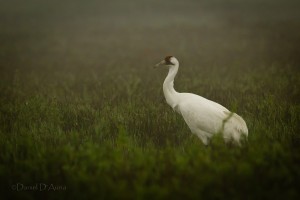MY OPINION ON THE CURRENT WHOOPING CRANE COUNT METHODS
BY: Tom Stehn
Retired Whooping Crane Coordinator
Aransas Pass, TX 78336
The whooping cranes are back at Aransas, and the Refuge has started their winter whooping crane counts. After I retired in the fall of 2011, count methods were changed from the complete census done for the past 61 years to a survey method using hierarchical distance sampling. I was told this was done for policy reasons, and that there were now too many whooping cranes to count them all. The latter statement is untrue; I successfully counted the cranes for 29 winters, including a peak of 282 whooping cranes, and feel a complete census will work with a flock size of at least 500. It may be that on some future date, it will be appropriate to sample the population rather than count all individuals, but I do not believe that date has yet arrived.
The new survey methods employ fixed transects flown at 1,000 meter intervals over four hours, whereas the census transects I used averaged ~400 meters wide and flights lasted approximately six hours. It is incomprehensible how the new survey method that finds fewer cranes is considered better than an actual census. To me, the more cranes you actually locate, the more you are going to learn. Why settle for an “estimate” when you have the opportunity to count nearly every individual each time you fly?
For the first winter since the refuge was established in 1937, no peak flock size was obtained in the 2011-2012 winter using the new distance sampling methods. Yes, the cranes were more dispersed that winter due to minimal food resources at Aransas, and the Service had difficulty finding approved aircraft to conduct the flights. Even given these difficulties, I would have come up with a peak population estimate using my old census methodology. Last winter, the new distance sampling methodology estimated 254 plus or minus 62 whooping cranes in the survey area. No one knew if the flock had increased or decreased in size from the previous year. This degree of uncertainty is simply unacceptable and useless for recovery management purposes. I believe the census methods I employed had no more than a 2% error. I knew I was not off by much since the results were so consistent from week to week. The number of adult pairs on the wintering grounds always agreed closely with the number of nesting pairs found the following summer in Canada. I averaged finding 95% of the cranes on every flight, and multiple flights over the winter season allowed me to put together the jigsaw puzzle of the flock composition (adults, subadults, juveniles, territory locations, mortality, habitat use, etc). The new survey methods do not attempt to locate territories or detect mortality, two actions recommended in the Recovery Plan.
Because the new survey methods are unproven and stakeholders are skeptical, I believe it would be prudent to continue to use the old census method while experimenting with the new method. Only when the new method is shown to be better should it be employed as the only survey methodology. I have written a letter to the Director of the USFWS and to the Director of Region II asking that they insure the flock gets censused this December before it is too late to obtain a peak count. If you agree with me, perhaps you might write a letter.
Whooping cranes are too valuable and too endangered not to count them annually to monitor how the flock is doing and how they are being impacted by numerous threats (sea level rise, housing developments, long-term decline of blue crabs, drought, invasion of black mangrove, power line and wind tower construction in the flyway, habitat loss, etc). For many, the whooping crane is considered the flagship species of the Endangered Species program. Because of this high level of interest and scrutiny, an accurate count is of great interest, both nationally and internationally. We owe it to the American people, our Canadian partners, and other conservation partners to provide them with the level of accurate information to which they have become accustomed.
Although happily retired, I’m frustrated by the people involved with the count insisting that their new methods are “better” when results to date prove they are not. One can’t expect me to be objective, but on the other hand, I have as much knowledge as anybody of counting whooping cranes. I urge the USFWS to utilize transects no more than 500 meters apart which will enable them to find a much higher percentage of the crane flock. Why not do a census using 500 meter transects one day and conduct a distance sampling survey at 1000 meter transects the next day to compare methods? Biologists can then decide if distance sampling is a useful tool. But at five feet tall and with nothing to hide behind, it is not hard to find nearly every whooping crane from the air. Come on Fish and Wildlife Service; use the count methods that are the most effective.


